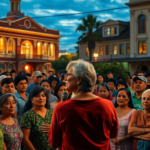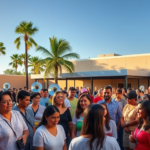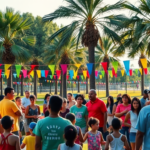U.S. Border Facilities for Migrant Children Show Improvement But Challenges Remain, Court Monitor Finds
Amid ongoing scrutiny, U.S. border facilities in Texas have shown notable improvements regarding the care of migrant children, though significant challenges persist. According to a recent court monitor’s report, changes in hygiene, food quality, and medical care highlight progress, but ongoing concerns regarding the temporary separation of children from their adult relatives need to be addressed.
Summary of Recent Developments
The findings are part of a report released last week under a court-appointed monitoring agreement set to conclude in January 2025. The report provides a snapshot of conditions at various U.S. Customs and Border Protection (CBP) facilities, including the main detention center for unaccompanied children in Donna, Texas. “Over the past two years, significant measures have been taken to improve conditions for vulnerable populations, particularly children,” stated CBP in an official communication, outlining new guidelines and training initiatives aimed at maintaining family unity.
Migrant children’s welfare at the border has been a contentious issue, especially in the Rio Grande Valley, where many families cross into the United States. The implementation of these measures marks a deliberate effort to mitigate concerns raised by advocates and stakeholders within South Texas communities.
Background and Local Impact
The report correlates with improvements observed since 2022 when a temporary monitoring agreement was put in place. The initiative, a response to lawsuits over unsafe and overcrowded conditions, particularly benefits regions like the Rio Grande Valley, a primary entry point for many migrants. Local advocacy groups, such as Children’s Rights, have emphasized the necessity of oversight to safeguard children’s well-being, citing past overcrowding that led to unsanitary and dangerous living conditions.
“The visible progress is encouraging, but there’s still a long way to go to ensure every child in custody receives adequate care and support,” warns Leecia Welch, Deputy Litigation Director at Children’s Rights, who plays a pivotal role in representing detained children under the Flores settlement.
Community Perspectives
Local community members in the Valley have followed these developments closely. Laura Jimenez, a Weslaco resident and volunteer with a local migrant shelter, stresses the need for ongoing advocacy. “The children are vulnerable and relying on the system not just for immediate safety, but also for their futures. It’s crucial that these efforts continue beyond 2025 to ensure lasting change,” she advocates.
The RGV community, rich in cultural diversity and humanitarian spirit, stands to gain from improvements in border facility conditions. Enhancements in care can alleviate the strain placed on local resources, allowing non-profit organizations and shelters to focus on rehabilitation and integration efforts.
Future Implications
The impending conclusion of the monitoring agreement in early 2025 raises questions about the sustainability of improvements seen to date. With changes in administrative focus on the horizon, the RGV community remains vigilant about policy shifts that could affect migrant welfare. “What’s important is not to lose momentum, especially with political transitions on the doorstep,” comments Rosa Martinez, an Edinburg-based immigration attorney.
Continued oversight and policy advocacy will be essential to prevent regression into former problematic practices, particularly those separation policies that are temporarily reintroduced despite public opposition and legal challenges.
Valley Community Resources
For Valley residents seeking information about their rights or wishing to support local advocacy initiatives, resources are available. Community forums featuring legal experts and humanitarian advocates are being planned to update residents on the impacts of ongoing and potential future policy changes. Information can be accessed through local media outlets like RGV Local News and community centers, ensuring broad dissemination of critical updates.
In conclusion, while the enhancements in border facilities for migrant children illustrate concerted effort towards humane treatment, the RGV community remains poised to press for continued reform and proactive measures. This transitional period presents opportunities to solidify these gains, ensuring that the region serves as a model for compassion and effective policy implementation amidst complex immigration dynamics.







